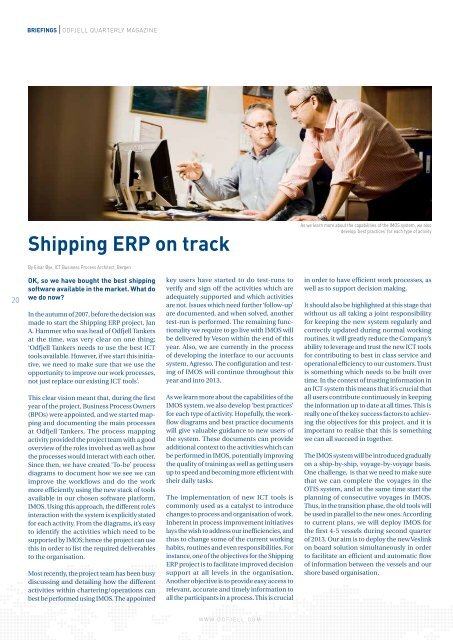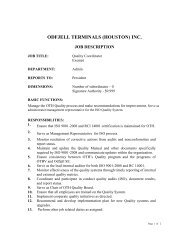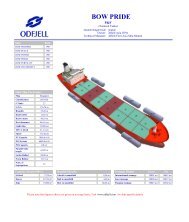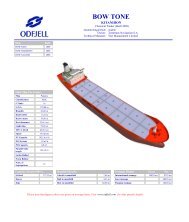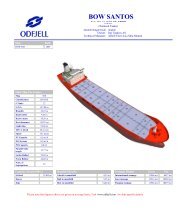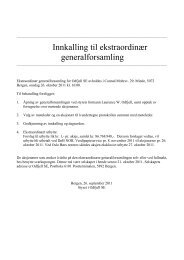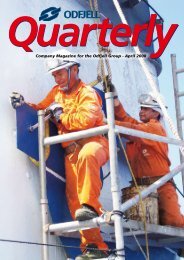Odfjell Quarterly October 2012
Odfjell Quarterly October 2012
Odfjell Quarterly October 2012
- No tags were found...
You also want an ePaper? Increase the reach of your titles
YUMPU automatically turns print PDFs into web optimized ePapers that Google loves.
BriefingsODFJELL QUARTERLY magazineShipping ERP on trackAs we learn more about the capabilities of the IMOS system, we alsodevelop 'best practices' for each type of activityBy Einar Øye, ICT Business Process Architect, Bergen20OK, so we have bought the best shippingsoftware available in the market. What dowe do now?In the autumn of 2007, before the decision wasmade to start the Shipping ERP project, JanA. Hammer who was head of <strong>Odfjell</strong> Tankersat the time, was very clear on one thing;‘<strong>Odfjell</strong> Tankers needs to use the best ICTtools available. However, if we start this initiative,we need to make sure that we use theopportunity to improve our work processes,not just replace our existing ICT tools’.This clear vision meant that, during the firstyear of the project, Business Process Owners(BPOs) were appointed, and we started mappingand documenting the main processesat <strong>Odfjell</strong> Tankers. The process mappingactivity provided the project team with a goodoverview of the roles involved as well as howthe processes would interact with each other.Since then, we have created ‘To-be’ processdiagrams to document how we see we canimprove the workflows and do the workmore efficiently using the new stack of toolsavailable in our chosen software platform,IMOS. Using this approach, the different role’sinteraction with the system is explicitly statedfor each activity. From the diagrams, it’s easyto identify the activities which need to besupported by IMOS; hence the project can usethis in order to list the required deliverablesto the organisation.Most recently, the project team has been busydiscussing and detailing how the differentactivities within chartering/operations canbest be performed using IMOS. The appointedkey users have started to do test-runs toverify and sign off the activities which areadequately supported and which activitiesare not. Issues which need further ‘follow-up’are documented, and when solved, anothertest-run is performed. The remaining functionalitywe require to go live with IMOS willbe delivered by Veson within the end of thisyear. Also, we are currently in the processof developing the interface to our accountssystem, Agresso. The configuration and testingof IMOS will continue throughout thisyear and into 2013.As we learn more about the capabilities of theIMOS system, we also develop ‘best practices’for each type of activity. Hopefully, the workflowdiagrams and best practice documentswill give valuable guidance to new users ofthe system. These documents can provideadditional context to the activities which canbe performed in IMOS, potentially improvingthe quality of training as well as getting usersup to speed and becoming more efficient withtheir daily tasks.The implementation of new ICT tools iscommonly used as a catalyst to introducechanges to process and organisation of work.Inherent in process improvement initiativeslays the wish to address our inefficiencies, andthus to change some of the current workinghabits, routines and even responsibilities. Forinstance, one of the objectives for the ShippingERP project is to facilitate improved decisionsupport at all levels in the organisation.Another objective is to provide easy access torelevant, accurate and timely information toall the participants in a process. This is crucialin order to have efficient work processes, aswell as to support decision making.It should also be highlighted at this stage thatwithout us all taking a joint responsibilityfor keeping the new system regularly andcorrectly updated during normal workingroutines, it will greatly reduce the Company’sability to leverage and trust the new ICT toolsfor contributing to best in class service andoperational efficiency to our customers. Trustis something which needs to be built overtime. In the context of trusting information inan ICT system this means that it’s crucial thatall users contribute continuously in keepingthe information up to date at all times. This isreally one of the key success factors to achievingthe objectives for this project, and it isimportant to realise that this is somethingwe can all succeed in together.The IMOS system will be introduced graduallyon a ship-by-ship, voyage-by-voyage basis.One challenge, is that we need to make surethat we can complete the voyages in theOTIS system, and at the same time start theplanning of consecutive voyages in IMOS.Thus, in the transition phase, the old tools willbe used in parallel to the new ones. Accordingto current plans, we will deploy IMOS forthe first 4-5 vessels during second quarterof 2013. Our aim is to deploy the new Veslinkon board solution simultaneously in orderto facilitate an efficient and automatic flowof information between the vessels and ourshore based organisation.www.odfjell.com


